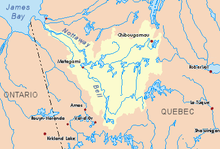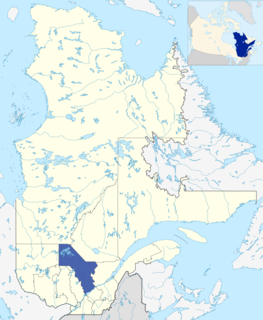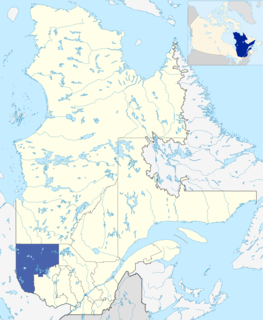| Pascagama | |
|---|---|
 Watershed of Nottaway River | |
| Location | |
| Country | Canada |
| Province | Quebec |
| Region | Nord-du-Québec |
| Physical characteristics | |
| Source | Marceau Lake |
| ⁃ location | La Tuque, Mauricie, Quebec |
| ⁃ coordinates | 48°57′06″N75°01′22″W / 48.95167°N 75.02278°W |
| ⁃ elevation | 464 m (1,522 ft) |
| Mouth | Pascagama Lake |
⁃ location | Senneterre, Abitibi-Témiscamingue, Quebec |
⁃ coordinates | 48°37′52″N75°33′25″W / 48.63111°N 75.55694°W Coordinates: 48°37′52″N75°33′25″W / 48.63111°N 75.55694°W |
⁃ elevation | 393 m (1,289 ft) |
| Length | 82.5 km (51.3 mi) [1] |
The Pascagama River is a tributary of Pascagama Lake. It flows in the Northwest of Quebec, in Canada, in the administrative regions of:

Pascagama Lake is a freshwater body of the eastern part of Senneterre in La Vallée-de-l'Or Regional County Municipality (RCM), in the administrative region of Abitibi-Témiscamingue, in the province of Quebec, in Canada. This body of water extends in the townships of Deschamps, Logan and Bernier.

Quebec is one of the thirteen provinces and territories of Canada. It is bordered to the west by the province of Ontario and the bodies of water James Bay and Hudson Bay; to the north by Hudson Strait and Ungava Bay; to the east by the Gulf of Saint Lawrence and the province of Newfoundland and Labrador; and to the south by the province of New Brunswick and the US states of Maine, New Hampshire, Vermont, and New York. It also shares maritime borders with Nunavut, Prince Edward Island, and Nova Scotia. Quebec is Canada's largest province by area and its second-largest administrative division; only the territory of Nunavut is larger. It is historically and politically considered to be part of Central Canada.

Canada is a country in the northern part of North America. Its ten provinces and three territories extend from the Atlantic to the Pacific and northward into the Arctic Ocean, covering 9.98 million square kilometres, making it the world's second-largest country by total area. Its southern border with the United States, stretching some 8,891 kilometres (5,525 mi), is the world's longest bi-national land border. Canada's capital is Ottawa, and its three largest metropolitan areas are Toronto, Montreal, and Vancouver.
Contents
- Mauricie: in the extreme west of the territory of the town of La Tuque (canton of Deschamps);
- Abitibi-Témiscamingue: in the easternmost part of Senneterre, in the La Vallée-de-l'Or Regional County Municipality (RCM), where is its mouth. In this region, the course of the river successively crosses the townships of Marceau, Buteux, Lagacé, Coursol and Juneau.

Mauricie is a traditional and current administrative region of Quebec. La Mauricie National Park is contained within the region, making it a prime tourist location. The region has a land area of 35,855.22 km² and a 2006 census population of 258,928 residents. Its largest cities are Trois-Rivières and Shawinigan.

Abitibi-Témiscamingue is an administrative region located in western Québec, Canada, along the border with Ontario. It became part of the province in 1898. It has a land area of 57,674.26 km2. The region is divided into five regional county municipalities and 79 municipalities. Its economy continues to be dominated by resource extraction industries. These include logging, mining all along the rich geologic Cadillac Fault between Val-d'Or and Rouyn-Noranda, as well as agriculture.

Senneterre is a town in the Abitibi-Témiscamingue region of northwestern Quebec, Canada. It is in the Vallée-de-l'Or Regional County Municipality. The town's territory includes a vast undeveloped area stretching from the Bell River to the Mauricie region. The town centre itself is about 60 km (37 mi) northeast of Val-d'Or on the banks of the Bell River, at the intersection of the Canadian National Railway and Quebec Route 113.
Forestry is the main economic activity of this watershed; recreational tourism activities come second.
The surface of the river is usually frozen from early November to the end of April, however, safe ice circulation is generally from early December to mid-April.






